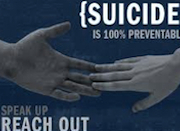YouTube video of assisted suicide could sway vulnerable people
 The Daily Telegraph and Daily Mail have both reported on the tragic story of a British couple in their 80s who died in a suicide pact at their home in Victoria Australia last Thursday.
The Daily Telegraph and Daily Mail have both reported on the tragic story of a British couple in their 80s who died in a suicide pact at their home in Victoria Australia last Thursday.
In the same article Nitschke said that the so-called peaceful pill should be ‘available in the supermarket so that those old enough to understand death could obtain death peacefully at the time of their choosing’.
It is well-established that the occurrence of one suicide can lead to another suicide. This phenomenon is the ‘Werther effect’, otherwise termed ‘copy cat’ suicide, ‘suicide contagion or ‘suicide cluster’.
It is also well-established that how the media reports a suicide can influence whether other suicides will follow.
The World Health Organization has developed guidelines for reporting suicide to minimize other suicides which state that ‘the degree of publicity given to a suicide story is directly correlated with the number of subsequent suicides. Cases of suicide involving celebrities have had a particularly strong impact’.
The WHO guidance on the media coverage of suicide is very clear:
•Don’t report specific details of the method used
•Don’t publish photographs or suicide notes
•Don’t glorify or sensationalize suicide
•Highlight alternatives to suicide
•Provide information on help lines and community resources
•Publicize risk indicators and warning signs
The YouTube video violates all six of these guidelines.
The BBC editorial guidelines on suicide and assisted suicide are equally unambiguous:
Suicide, attempted suicide and self-harm should be portrayed with great sensitivity, whether in drama or in factual programmes. Factual reporting and fictional portrayal of suicide, attempted suicide and self-harm have the potential to make such actions appear possible, and even appropriate, to the vulnerable.
In Oregon, where assisted suicide was made legal in 1997 general suicide rates (in addition to those who are dying under the provisions of the Death with Dignity Act) are rising significantly.
Oregon’s suicide rate is 35 percent higher than the national average; 15.2 suicides per 100,000 people compared to the national rate of 11.3 per 100,000.
After decreasing in the 1990s, suicide rates have been increasing significantly since 2000, according to a new report, ‘Suicides in Oregon: Trends and Risk Factors,’ from Oregon Public Health.
The report noted a marked increase in suicides among middle-aged women. The number of women between 45 and 64 years of age who died from suicide rose 55 percent between 2000 and 2006 — from 8.2 per 100,000 to 12.8 per 100,000 respectively.
The highest suicide rate occurred among men ages 85 and older (78.4 per 100,000). White males had the highest suicide rate among all races and ethnicities (26.5 per 100,000).
It is hard to imagine that the legalisation of assisted suicide in Oregon has not at least in part contributed to this state of affairs.
The danger to elderly people of publicising joint suicides has been noted before and is well recognised in the medical literature.
A 2003 report which has just come into the public domain, titled ‘The Werther Effect and Assisted Suicide’, tells of a large epidemiological study in the region of Basle, Switzerland, from 1992 to 1996, in which a considerable rise in suicides assisted by the right-to-die society EXIT was uncovered after wide press coverage of an assisted double suicide of a prominent couple in that region in March 1995. It also notes that women over 65 are particularly vulnerable.
The posting of this YouTube video is in breach of the WHO guidance on the handling of suicide by the media. It risks promoting other similar suicides and should be removed immediately.




Leave a Reply
Want to join the discussion?Feel free to contribute!